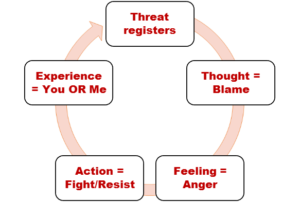Navigating Conflict at Work (but I hate confrontation!)
Navigating conflict….if we didn’t learn it as young people….
It’s no surprise that many of us suck at resolving disagreements. If our parents didn’t fight fairly or fight at all, then we learned how to avoid things that make us uncomfortable. Stepping out on a gender and geography limb, I offer that southern women are taught explicitly not to rock the boat. Instead, subterfuge and covert warfare is a well-refined skill set among this demographic. However, without sufficient tactical training at navigating conflict, there’s frequent opportunity for disagreements to open a divide between people who must work together, ideally, effectively.
Beyond how it makes us feel (sick, frustrated, angry), conflict at work is a huge drain on morale and productivity for a company. Work conflict can lead to sick days (avoidance), a loss of satisfaction for the job (disengagement), consideration of leaving the job for another one (giving up), or bringing the conflict home (stewing).
We’ve all been there. A co-worker does something, says something, or won’t do something and it makes us batty. And rather than just own your version of the story with a “You may not be aware of this so I wanted to let you know, I am really upset with how that meeting went and how the issue of the project assignments was handled. Can you help me understand why those choices were made so I may better appreciate the situation and put it behind me?” I know, I know. When we are hurt or angry or just plain riled up our rationale brain (hello Pre-Frontal Cortex) is bullied into submission by our Mid-brain which says CONFLICT! CRISIS! BLAME! Did I mention BLAME? And please, some MORE BLAME just in case!
Brain Hijack and Conflict at Work
How often have you said “I am so mad I can’t see straight”? The reaction is brain hijack. Essentially, the overload of anger and similar emotions commandeer the brain’s resources via the Amygdala, a structure in our brain that is devoted to assigning value to an experience. It’s like Chicken Little yelling “the sky is falling! The sky is falling!” Thanks to biology, brain hijack occurs through a series of chemical events when one of our proverbial buttons is pushed. Until those chemicals have returned to their resting state, you will be in a state of brain hijack and thus, your rationale and thoughtful self is not available for consultation. You know how they say do not send an email that you’ve written in anger? Warning! It’s good advice for a biological reason as well as a self-preservation one.
Stop, Drop, and Roll (not really)
Because successfully navigating conflict at work translates to navigating conflict anywhere in your life, here is a strategy that might serve you:
- Own your story. If you are hurt and really pissed off about what your coworker did, first BREATHE. Send some much needed oxygen to your brain. Then ask yourself what button in YOU was pushed. What core value(s) was threatened? What insecurity landmine went kaboom? Achieving this self- awareness is the vital first step to changing the experience the next time. It forces your brain back into rational mode, too.
- Seek clarification instead of confrontation. Make sure your version of what happened is what actually happened. Do not live in the distorted land of 100 assumptions. Ask other people who were there or are directly involved what their take on the situation is. If your version of the story is not confirmed by others, then quite likely, it’s neither true nor matches the story belonging to the person you’re blaming for the way you feel.
- To speak or not to speak. Decide whether speaking directly to the person on the other end of the conflict is a person of influence. Meaning, if the delivery guy pissed you off and you don’t plan to order from that restaurant again, then perhaps choosing to let it go is the best course. If he/she is someone on your team and you work with them every day, then it’s worth it to gird your loins and have a conversation. Yes, it’s a scary idea. Yes, it might not go well. However, like anything you choose to become good at – you have to PRACTICE. There is no other way but to go straight through.
- Practice. If you plan to seek a conversation, imagine or write down what you’d like to say. Imagine the ideal outcome. Appreciate what parts you can own and what parts you cannot. Include the facts – You feel WHAT? Because WHY? And HOW might we be able to improve things through WHAT course of action?
- Release expectations. Say your peace and have no expectation about their response. This is VITAL. We control what we say, when we say it, and how we offer it. We CANNOT dictate what they say, do or how they respond. If we are dependent upon a specific response – we set ourselves up for more discomfort. If you get a wholly unsatisfying response, so be it. Be proud of your effort to take thoughtful action.
- Leave the training wheels of BLAME at the door. They only serve to protect you in the moment. No one can push a button unless it was already installed and we elected to leave it on the wall of our insides. Seriously folks, in the realm of emotional experience people do not do things to us. We allow ourselves to be mad or hurt when we choose to take things personally. So what if we allow that whatever they say/do is about THEM and whatever we believe/feel is about US? It changes everything when we take responsibility for what we feel. Blame prevents that from happening. If we never stop blaming – then we don’t get to move on to the next step.
The Power of Conflict Resolution
When we successfully navigate the process of conflict resolution once, we can do it again and again. It can become a skill in the repertoire of effective communication. And while in the moment of NOW, when all we want to do is be mad, recognizing that we have choices is so powerful. Think about it. When we don’t believe we have choices – we feel powerless. With the tools to be able to convert a disagreement into an alliance – that’s where real power begins. Work may not feel so much like work after all.


